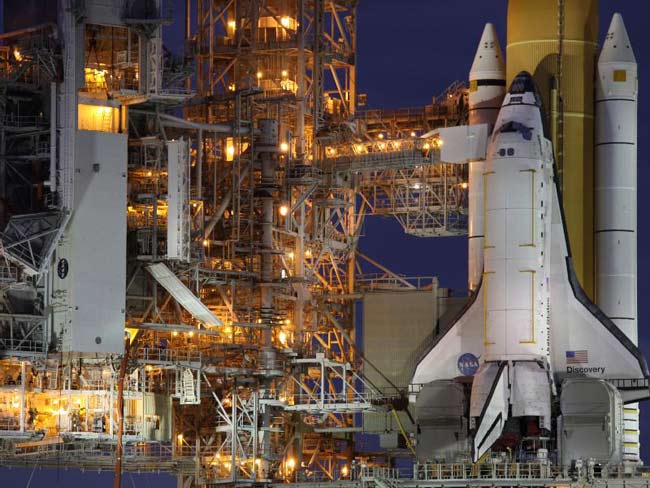NASA's Tricky Art of Choosing Space Shuttle Launch Windows

Thisstory was updated at 6:50 a.m. ET, Nov. 4.
CAPECANAVERAL, Fla. ? NASA has delayed the final launch of space shuttle Discovery severaltimes in the last week, most recently to no earlier than Nov. 5, due to rainy conditions at the launch site. But the shuttles must fly within a given window, andrescheduling a launch can be a tricky task.
Choosinga new space shuttle launch date means more thansimply shifting everything forward a day or two. The liftoff must occur withina designated launch window to keep the spacecraft on target for its intendeddestination.
ForDiscovery, that destination is the International SpaceStationand the launch window opened Nov. 1 and closes on Sunday, Nov. 7. There is achance the window could be extended to Monday, Nov. 8, NASA spokesman AllardBeutel told SPACE.com.
Thewindow closes around Nov. 8 because after that date, the angle of sunlight onDiscovery when it would be docked at the space station becomes unfavorable andcould cause some parts to overheat. If Discovery does not launch by the end of the window,NASA would have to wait until Dec. 1 when the sun angles are once againfavorable. [INFOGRAPHIC: NASA'sSpace Shuttle from Top to Bottom]
Shiftinglaunch times
Eachday a shuttle launch is delayed, the optimum time to make the next launchattempt is slightly different, typically moving up earlier in the day.
Breaking space news, the latest updates on rocket launches, skywatching events and more!
Discoverywas originally scheduled to launch Nov. 1 at 4:40 p.m. EDT (2040 GMT). Sincethen, the launch has been delayed two days due to helium and nitrogengas leaks,and then another day because of an electrical glitch in a backupcomputer for one of Discovery's three main engines.
Now,if NASA is able to launch Discovery Friday, Nov. 5, liftoff would occur at 3:04 p.m.EDT (1904 GMT). A launch try on Sunday at the end of the window would occur at1:15 p.m. EST (1815 GMT). A launch on Sunday would come after the switch fromDaylight Savings Time to Standard Time.
Target:International Space Station
Todetermine the launch window for Discovery's STS-133 mission, there are severalcritical factors scientists consider in addition to sun angles. Launch delayshave ripple effects for the entire mission's timeline, particularly theshuttle's rendezvous and docking times at the International Space Station.
Thelimited amount of fuel onboard the shuttle means the docking times are calculatedbased on the station's location above the launch site at Kennedy Space Centerhere in Florida.
Thespace station flies over the space center twice a day for about 10 minutes ateach pass. Shuttle launch times are set to when the angle of Earth's rotationwill allow the orbiter to slip into the same plane that the space station isflying in. Those times shift with each passing day.
For example, Discovery is now slated to lift off at 3:04 p.m.EDT on Friday ? 96 minutes earlier in the day than on its original launchtarget four days earlier.
The shift keeps Discovery on track for its arrival at thestation whileboth fly 220 miles (354 km) above Earth ? traveling 17,500 mph (28,164kph) ? two days after launch.
But that's not all.
Thereare also additional variables that can dictate potential launch windows andlaunch times, including the astronaut crew's sleep cycle, where the shuttle'sexternal tank and solid rocket boosters will be released, wind and otherweather forecasts on launch day, possible abort scenarios, mission-specificrequirements, and even desired re-entry and landing times.
This is why when launches are delayed, their liftoff times shift.
Onits 11-day mission, Discovery will haul critical spare parts to the spacestation, including a new storage room and a humanoid robot to assist the crewof the orbiting laboratory.
Discovery's finalflightwill be NASA's 133rd shuttle mission, before the space agency brings its30-year space shuttle program to a close in 2011.
NASAwill retire the three remaining shuttles in its fleet ? Discovery, Atlantis andEndeavour ? next year to make way for a new plan aimed at sending astronauts tovisit an asteroid and Mars. Discovery is the oldest of NASA's space shuttlescurrently flying and the first to be retired.
- INFOGRAPHIC: NASA's Space Shuttle ? From Top to Bottom
- Video ? Space ShuttleDiscovery: A Retrospective, Part 2, Part 3
- Gallery: BuildingSpace Shuttle Discovery
FollowSPACE.com Staff Writer Denise Chow on Twitter @denisechow as she coversDiscovery's final space voyage from Cape Canaveral, Fla. Click here for missionupdates, new stories and a link to NASA's live webcast coverage.

Denise Chow is a former Space.com staff writer who then worked as assistant managing editor at Live Science before moving to NBC News as a science reporter, where she focuses on general science and climate change. She spent two years with Space.com, writing about rocket launches and covering NASA's final three space shuttle missions, before joining the Live Science team in 2013. A Canadian transplant, Denise has a bachelor's degree from the University of Toronto, and a master's degree in journalism from New York University. At NBC News, Denise covers general science and climate change.
